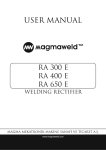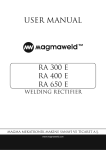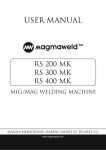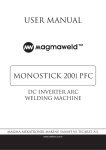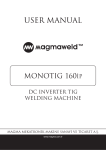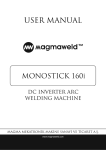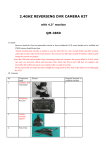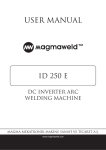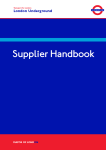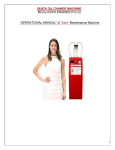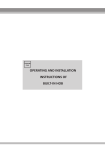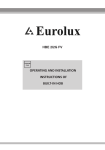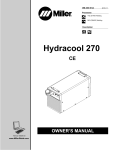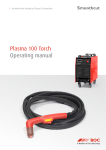Download Yeni TD 355 User Manual.cdr
Transcript
USER MANUAL TD 355 WELDING RECTIFIER www.magmaweld.com CONTENTS SAFETY RULES.................................................................................................................................................2 1. TECHNICAL INFORMATION .........................................................................................................................6 1.1 GENERAL EXPLANATIONS....................................................................................................................6 1.2 COMPONENTS OF TD 355.....................................................................................................................6 1.3 DATA PLATE ............................................................................................................................................7 1.4 TECHNICAL SPECIFICATIONS...............................................................................................................7 1.5 ACCESORRIES .......................................................................................................................................7 2. INSTALLATION ..............................................................................................................................................8 2.1 UPON RECEIPT AND CLAIMS................................................................................................................8 2.2 WORKING CONDITIONS ........................................................................................................................8 2.3 ELECTRIC PLUG CONNECTION ...........................................................................................................9 2.4 WELDING CONNECTIONS.....................................................................................................................9 2.5 CONNECTING TO THE MAINS...............................................................................................................9 2.6 WELDING ADJUSTMENTS .....................................................................................................................9 3. MAINTENANCE AND TROUBLESHOOTING..............................................................................................10 3.1 MAINTENANCE .....................................................................................................................................10 3.2 TROUBLESHOOTING ...........................................................................................................................10 APPENDIX 1: SPARE PARTS LIST FOR TD 355 ..........................................................................................11 APPENDIX 2: ELECTRICAL DIAGRAM FOR TD 355....................................................................................12 TD 355 1 SAFETY RULES OBEY ALL THE SAFETY RULES STATED IN THE MANUAL! IDENTIFYING SAFETY INFORMATION These symbols are being used to identify potential risks. When seen a safety symbol in the manual, it must be understood that there is an injury risk and following instructions must be read carefully to avoid potential risks. While welding, keep the third persons and especially the children away from the work area. UNDERSTANDING THE SAFETY WARNINGS Read carefully the manual and the labels and the safety warnings on the machine. Make sure that the warning labels positioned on your machine are in good order. Renew the damaged and the missing labels. Learn to operate the machine and how to make the controls properly. Operate your machine in convenient work areas. Improper modifications affect the safety of your machine negatively and shorten its lifetime. ELECTRICAL SHOCK CAN BE FATAL Installation procedure must comply with national electricity standards and other relevant regulations and ensure that installation is performed by qualified persons. Wear dry insulating gloves free of damage and body protection. Do not touch electrode with bare hand. Do not wear wet or damaged gloves and body protection. Do not touch live electrical parts. Never touch electrode while in contact with working surface, ground or another electrode which is connected to a different machine . Protect yourself from electric shock by insulating yourself from work and ground. Use non-flammable, dry insulating material if possible, or use dry rubber mats, dry wood or plywood, or other dry insulating material big enough to cover your full area of contact with the work or ground, and watch for fire. Never connect more than one electrode to the electrode holder. Turn off the machine, when not in use . Disconnect input plug or swtich off the power before working on the machine. Frequently inspect input power cord for damage or bare wiring - repair or replace cord immediately if damaged. Be sure that the machine is properly grounded. HOT PARTS CAN CAUSE SEVERE BURNS Do not touch hot parts. Allow cooling time before servicing. If needed to hold hot parts, use appropriate tool, insulating gloves and fireproof clothes. 2 TD 355 SAFETY RULES BREATHING WELDING FUMES CAN BE HAZARDOUS TO YOUR HEALTH Inhaling fumes and gases over a long period of time, generated during welding is dangerous and forbidden . Irritation of the eyes, nose and throat are symptoms of inadequate ventilation. Take immediate steps to improve ventilation. Do not continue welding if symptoms persist. Install a natural or forced air ventilation system in the work area. Install an adequate ventilation system in the welding and cutting area, if needed install a system that can remove the fume and vapor accumulated in the entire work area, to prevent pollution use adequate filtration in discharge. In the event of welding in small, confined places, or welding lead, beryllium, cadmium, zinc, zinc coated or painted materials; also wear a fresh air supplied respirator in addition to the above mentioned rules . Always have a trained watchperson nearby, while working in small confined places. Avoid working in such confined places if possible. If gas cylinders are grouped in a different area, make sure that it is a well-ventilated area. When not being used, turn off the main cylinder valve and watch out for gas leakage . Shielding gasses such as argon is denser than air and when being used in confined places, it can be inhaled which is dangerous for health. Do not perform welding operations near chlorinated hydrocarbon vapors produced by degreasing or painting. ARC RAYS CAN BURN EYES AND SKIN Use adequate welding helmet with correct shade of filter (4 or 13 considering EN 379) to protect your eyes and face. Protect open parts of your body (arms, neck and ears) from arc rays by adequate protective clothing. To protect others by arc rays and hot metals, surround the working area with flame proof curtains which are higher than eye level and put up warning boards. SPARKS & FLYING METALS CAN INJURE EYES Welding, wire brushing and grinding cause sparks and flying metal. To prevent injuries wear appropriate safety glasses with side shields even under your welding helmet . MOVING PARTS CAN CAUSE INJURY Keep away from moving parts. Keep all doors, panels, and guards closed and secured. Wear shoes with metal protection over the fingers. TD 355 3 SAFETY RULES NOISE CAN DAMAGE HEARING Noise from certain industrial processes or equipments can damage hearing. Wear approved ear protection if noise level is high. WORKING IN SMALL AND CONFINED PLACES CAN BE DANGEROUS While welding and cutting in small, confined places, always have a trained watchperson nearby. Avoid working in such confined places. WELDING WIRE MAY CAUSE INJURY Do not point the torch toward any part of a human body, other persons or any type of metal when unwinding welding wire. While extracting the wire from the spool by hand, it may spring suddenly and injure you or a nearby person, protect especially your eyes and face. WELDING CAN CAUSE FIRE OR EXPLOSION Never weld near flammable material. It may cause fire or explosions. Before starting to weld, move flammables away or protect them with flame-proof covers. Do not weld on and cut closed tubes or pipes. Before welding on closed containers, open and clear them entirely. Welding operations on these parts must be performed with the utmost caution. Never weld containers or pipes containing or which have contained substances that could give rise to explosions. Welding equipments warms up so never position them on flammable surfaces. Welding sparks can cause fire. For that reason, keep extinguishing means, such as fire extinguishers, water and sand which are easy to reach. Keep security valves, regulators and other valves, used on flammable, explosive and compressed gas circuits, in good condition. MAINTENANCE MADE BY UNQUALIFIED PERSONS MAY CAUSE INJURIES Electrical devices should not be repaired by unqualified persons. Improper repairs can cause serious injuries or even death during applications. The components of the gas circuit works under pressure. The service given by unqualified persons may cause explosions and operators can be injured seriously. 4 TD 355 SAFETY RULES FALLING UNIT CAN CAUSE INJURY Wrong positioned power source or other equipment may cause serious injury to persons or damage to objects. While repositioning the power source always carry by using the lifting eye. Never pull cable, hose or torch. Always carry the gas cylinders separately. Before carrying the welding and cutting equipment, disassemble all the connections between and separately carry the small ones by handgrips and the big ones by lifting eyes or by using appropriate vehicles like forklifts. Install your machine on flat platforms having maximum 10° slope that it does not fall over. Install it on well ventilated, non-confined places away from the dust, also avoiding the risk of falling caused by cables and hoses. For gas cylinders not to fall over, attach it to the mobile machine or to the wall with a chain. Ensure that operators easily reach the controls and connections on the machine. OVERUSE CAN CAUSE OVERHEATING Allow cooling period; follow rated duty cycle. Reduce current or reduce duty cycle before starting to weld again. Do not block airflow through the unit. Do not filter airflow to unit without the approval of manufacturer. ARC WELDING CAN CAUSE INTERFERENCE Electromagnetic energy arising during welding and cutting operations can interfere with sensitive electronic equipment such as microprocessors, computers, and computer-driven equipment such as robots. Be sure all equipment in the welding area is electromagnetically compatible. To reduce possible interference, keep weld cables as short as possible, close together, and down low, such as on the floor. To avoid possible EMC damages, locate welding operation as far as possible (100 meters) from any sensitive electronic equipment. Be sure this welding machine is installed and grounded according to this manual. If interference still occurs, the user must take extra measures such as moving the welding machine, using shielded cables, using line filters, or shielding the work area . PROTECTION Do not expose the welding machine to rain, protect from water drops and vapour. ENERGY EFFICIENCY Choose appropriate welding method and welding machine for your work. Choose appropriate welding current and welding voltage for the material and its thickness. If you will have a long break after welding, turn off the machine after cooler fan cooled the machine. TD 355 5 TECHNICAL INFORMATION 1. TECHNICAL INFORMATION 1.1 GENERAL EXPLANATIONS TD 355 is a moving-coil welding machine, designed to weld all type of coated electrodes from 2.0 to 5.0 mm. Excellent welding performance with cellulosic electrodes. The equipment is very easy to use, current adjustment is made by just turning the lever in front of the machine clockwise or counter clockwise and adjusted value of the current is observed by the scale on the machine. Although it is not an electrically efficient machine, due to its very simple concept, it is down time and operation costs are very low. Since there is no electronics involved, the machine can perform great at dusty, humid, corrosive, very hot and very cold environments. With its telescopic arms and big wheels it can be pulled easily across the working area especially at outdoor welding sites. The machine is fan cooled and thermally protected against overheating and phase failures. 1.2 COMPONENTS OF TD 355 4 1 5 O I TD 355 6 7 2 3 Figure 1: Components of TD 355 1 2 3 4 6 Power Switch Current Adjustment Lever Welding Cable Sockets (+ and -) Current Adjustment Indicator 5 Lifting Eye 6 Handle 7 Wheel TD 355 TECHNICAL INFORMATION 1.3 DATA PLATE MAGMA MEKATRONİK MAKİNE SAN. VE TİC. A.Ş. Organize Sanayi Bölgesi 5. Kısım Manisa-TÜRKİYE X U0 U1 U2 I1 I2 IP 22 S1 CL.I. H EN 60974-1 EN 60974-10 TD 355 Seri No : 60 A / 22,4 V - 350 A / 34 V 35 % 60 % X U0 V 54 - 64 U1 3R CL.I. H 320 A 244 A 189 A U2 33 V 30 V 28 V I1 V 380 A S1 I1 A I1 A 31 24 18 20 kVA 16 kVA 12 kVA T 32 A 50 Hz 100 % I2 :Duty Cycle* :Open Circuit Voltage :Line Voltage and Frequency :Rated Welding Voltage :Input Current :Rated Welding Current :Protection Class :Input Power :Insulation Class 3R 3 Phase Transformer Rectifier Descending Characteristics S IP 22 Stick Electrode Welding Fuse Line Input 3 Phase Alternative Current 3R S Appropriate To Operate In Dangerous Work Area Direct Current *Duty Cycle Temperature (°C) 1 6 min. 2 4 min. 6 min. 4 min. 6 min. 4 min. Time (min.) Duty cycle defines the percentage of welding time out of a period of 10 minutes at a given current and ambient temperature (standard is 40°C). For example, a welder with 60% duty cycle must be rested (2) for 4 minutes, after 6 minutes of continuous welding (1). 1.4 TECHNICAL SPECIFICATIONS UNIT VALUE V 380V / 50 Hz Input Power (%35) kVA 20 Input Current (%35) A 31 Recommended Line Fuses A 3x32 Open Circuit Voltage VDC 54 - 64 Welding Current Range ADC 60 - 350 Rated Welding Current (%35) ADC 320 Dimensions (LxWxH) mm 950x660x650 kg 125 TECHNICAL SPECIFICATIONS Line Voltage (3 Phases) Weight Protection Class IP22 1.5 ACCESORRIES QUANTITY PRODUCT CODE Electrode Holder and Cable (35 mm2-5 m) 1 K301000405 Earth Clamp and Cable (35 mm -3 m) 1 K301100403 STANDARD ACCESORRIES 2 TD 355 7 INSTALLATION&OPERATION 2. INSTALLATION 2.1 UPON RECEIPT AND CLAIMS Be sure that you have received all the items that you have ordered. In case of any item is missing or damaged, contact your supplier immediately. In the event of damaged or missing delivery, draw up a record, take a photo of the damage and report it to the shipping agency and MAGMA MEKATRONIK with the photocopy of shipping bill. Standard pallet contains: ú Power Source ú Electrode Holder Cable ú Earth Clamp Cable ú User Manual E-mail: [email protected] Fax: +90 236 226 27 28 2.2 INSTALLATION AND WORKING RECOMMENDATIONS • Use lifting eyes or fork-lift to carry the machine. Transport and place the device on a firm and level ground so that it may not fall over. The maximum permissible angle of inclination for transport and assembly is 10°. • For a better performance, keep the machine at least 30 cm away from the surrounding objects. Beware of excessive heat, dust and humidity around the machine. Try not to operate the machine under direct sunlight. Machines should be operated on lower capacities when ambient air temperature exceeds 40ºC. • Avoid welding at outdoors where it is windy and rainy, if this is a must, protect the welding area with curtains, mobile screens or tents. 8 • Ensure that operators can easily reach the machine controls and connections. • Use suitable welding fume extraction systems. Use breathing apparatus if there is a risk of inhaling in confined places. • Respect the duty cycles given at the data plate. Exceeding the duty cycles frequently can damage the machine and this would void the warranty. • Do not use stronger fuses than those stated on the data plate. • Ensure that the earth clamp is tightly connected as close as possible to the welding location. Do not let welding current flow through any media other than welding cables; e.g. over the machine itself, gas tubes, chains, ball bearings, etc. TD 355 INSTALLATION&OPERATION 2.3 ELECTRIC PLUG INSTALLATION AND CONNECTION TO THE MAINS Since mains connection sockets may vary from factory to factory, an appropriate plug must be installed to the built-in mains cable of the machine by qualified electricians. Please observe that the earth cable is in yellow/green colour and labelled as . Figure 2: Electric Plug Connection While inserting the plug into the mains socket, pay attention that main switch is positioned to “OFF” “0”. Before plugging your machine to the electrical line check carefully the 3 phase with a voltmeter and then insert the plug into the mains socket. SWITCH ON the machine via power switch (1) and observe the fan noise and illumination of the power lamp. Figure 3: Mains Connection 2.4 WELDING CONNECTIONS According to the electrode to be used, insert the welding cables, with correct polarity into the welding and earth cable sockets (3) and tighten them by turning clock-wise. Connect the earth clamp tightly to the workpiece as close as possible to the welding area. 3 Figure 4: Welding Cable Sockets 2.5 WELDING ADJUSTMENTS Below table is given as a reference for current 2 adjustment of mild steel electrodes, please refer to the electrode manufacturer's recommendations Diameter Rutile Basic Cellulosic 2.0 40-60 A -- -- Figure 5: Current Adjustment Lever 2.5 60-90 A 60-90 A 60-100 A By turning the current adjustment lever (2) 3.25 100-140 A 100-130 A 70-130 A 4.0 140-180 A 140-180 A 120-170 A 5.0 200-240 A 200-250 A 160-200 A clockwise, current is increased (Figure 5). Approximate value of the adjusted current can be read on the current adjustment indicator (4) above the machine. The machine is ready to weld. TD 355 9 MAINTENANCE AND TROUBLESHOOTING 3. MAINTENANCE AND TROUBLESHOOTING Obey all the safety rules during maintenance and troubleshooting. Before removing any screw on the machine for maintenance, power supply must be disconnected from the electric lines. 3.1 MAINTENANCE ONCE IN EVERY 3 MONTHS Clean the labels on the machine, replace the labels that worn out. Repair or replace the worn out welding cables. Clean and tighten the weld terminals. Check the isolation of the electrode holder, earth clamp and their cables. ONCE IN EVERY 6 MONTHS Open the covers of the machine and clean with dry air. OR NOTE: The above recommended maintenence periods are indicative, these may vary according to the work shop conditions. DO NOT PLUG THE MAINS ELECTRIC CABLE BEFORE CLOSING ALL THE CABINET PANELS. 3.2 TROUBLESHOOTING TROUBLE Machine does not work. Welding current is low. Fan is out of order. 10 REASON Phase failure No neutral line Fuse blown out Phase failure Diode unit breakdown Primary or secondary coil burn down Fan supply voltage phase failure Fan motor break down TD 355 APPENDIX 1 SPARE PARTS LIST FOR TD 355 4 8 7 12 5 10 9 11 6 1 2 3 13 5 DESIGNATION NO MATERIAL CODE 1 A310100008 Changeover Switch -16A 220V 2 K000000306 Current Adjustment Lever 3 A377900106 Welding Socket 4 K090300004 Current Scale 5 A430901008 Diode Group 6 K000000110 Current Adjustment Shaft 7 K302000004 Primary Coil 8 K302100004 Secondary Coil 9 K304000004 Main Transformer 10 A300190001 Glass Fuse Socket 11 A311200032 Contactor 12 A250200002 Cooling Ventilator 13 A225222012 Wheel A490400001 EMC Filter TD 355 11 APPENDIX 2 ELECTRICAL DIAGRAM FOR TD 355 12 S1 Changeover Switch F1 Glass Fuse Mf Ventilator Motor (220 VAC 0,18 kW 1450 rpm) Th1 Thermic (Diode Bridge) Th2 Thermic (Transformer) Br1 Diode Bridge Tr1 Main Transformer C1 Contactor TD 355 FACTORY Organize Sanayi Bölgesi 5.Kısım 5503. Sokak No:1 MANİSA +90 236 226 27 00 +90 236 226 27 28 OWM 02.02.2011 Made in TÜRKİYE www.magmaweld.com














